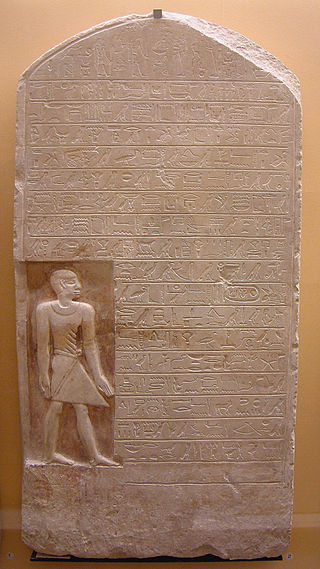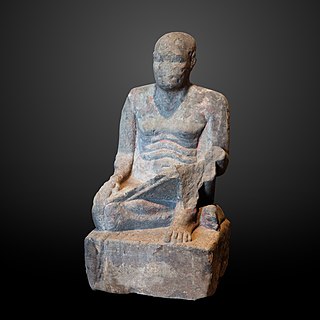Sobek was an ancient Egyptian deity with a complex and elastic history and nature. He is associated with the Nile crocodile or the West African crocodile and is represented either in its form or as a human with a crocodile head. Sobek was also associated with pharaonic power, fertility, and military prowess, but served additionally as a protective deity with apotropaic qualities, invoked especially for protection against the dangers presented by the Nile. Sobek has been famed for having been revered by the first female Pharaoh by the Nebty name Sat-Sekhem-Nebet-Tawy Sobekneferu, present both in the female Pharaoh's nomen, Sobekneferu, and her praenomen Kasobekre.

Amenemhat III, also known as Amenemhet III, was a pharaoh of ancient Egypt and the sixth king of the Twelfth Dynasty of the Middle Kingdom. He was elevated to throne as co-regent by his father Senusret III, with whom he shared the throne as the active king for twenty years. During his reign, Egypt attained its cultural and economic zenith of the Middle Kingdom.

The Middle Kingdom of Egypt is the period in the history of ancient Egypt following a period of political division known as the First Intermediate Period. The Middle Kingdom lasted from approximately 2040 to 1782 BC, stretching from the reunification of Egypt under the reign of Mentuhotep II in the Eleventh Dynasty to the end of the Twelfth Dynasty. The kings of the Eleventh Dynasty ruled from Thebes and the kings of the Twelfth Dynasty ruled from el-Lisht.

Senusret I also anglicized as Sesostris I and Senwosret I, was the second pharaoh of the Twelfth Dynasty of Egypt. He ruled from 1971 BC to 1926 BC, and was one of the most powerful kings of this Dynasty. He was the son of Amenemhat I. Senusret I was known by his prenomen, Kheperkare, which means "the Ka of Re is created." He expanded Egypt that allowed him to rule over an age of prosperity.

Gebel el-Silsila or Gebel Silsileh is 65 km (40 mi) north of Aswan in Upper Egypt, where the cliffs on both sides close to the narrowest point along the length of the entire Nile. The location is between Edfu in the north towards Lower Egypt and Kom Ombo in the south towards Upper Egypt. The name Kheny means "The Place of Rowing". It was used as a major quarry site on both sides of the Nile from at least the 18th Dynasty to Greco-Roman times. Silsila is famous for its New Kingdom stelai and cenotaphs.

The Thirteenth Dynasty of ancient Egypt is often combined with Dynasties XI, XII and XIV under the group title Middle Kingdom. Some writers separate it from these dynasties and join it to Dynasties XIV through XVII as part of the Second Intermediate Period. Dynasty XIII lasted from approximately 1803 BC until approximately 1649 BC, i.e. for 154 years.

Khasekhemre Neferhotep I was an Egyptian pharaoh of the mid Thirteenth Dynasty ruling in the second half of the 18th century BC during a time referred to as the late Middle Kingdom or early Second Intermediate Period, depending on the scholar. One of the best attested rulers of the 13th Dynasty, Neferhotep I reigned for 11 years.

Khaneferre Sobekhotep IV was one of the more powerful Egyptian kings of the 13th Dynasty, who reigned at least eight years. His brothers, Neferhotep I and Sihathor, were his predecessors on the throne, the latter having only ruled as coregent for a few months.

Khaankhre Sobekhotep was a pharaoh of the Thirteenth Dynasty of Egypt during the Second Intermediate Period.

Faiyum is a city in Middle Egypt. Located 100 kilometres southwest of Cairo, in the Faiyum Oasis, it is the capital of the modern Faiyum Governorate. Originally called Shedet in Egyptian, the Greeks called it in Koinē Greek: Κροκοδειλόπολις, romanized: Krokodilópolis, and later Medieval Greek: Ἀρσινόη, romanized: Arsinoë. It is one of Egypt's oldest cities due to its strategic location.

Ankhu was an Egyptian vizier of the early 13th Dynasty, who lived around 1750 BC.

The Faiyum Oasis is a depression or basin in the desert immediately west of the Nile river, or just 62 miles south of Cairo, Egypt. The extent of the basin area is estimated at between 1,270 km2 (490 mi2) and 1,700 km2 (656 mi2). The basin floor comprises fields watered by a channel of the Nile, the Bahr Yussef, as it drains into a desert hollow to the west of the Nile Valley. The Bahr Yussef veers west through a narrow neck of land north of Ihnasya, between the archaeological sites of El Lahun and Gurob near Hawara; it then branches out, providing rich agricultural land in the Faiyum basin, draining into the large saltwater Lake Moeris. In prehistory it was a freshwater lake, but is today a saltwater lake. It is a source for tilapia and other fish for the local area.

Mentuhotep was an ancient Egyptian official and treasurer under the 12th Dynasty pharaoh Senusret I. Mentuhotep is one of the best attested officials of the Middle Kingdom period. There is a series of statues found at Karnak, showing him as a scribe. On these he has been given the title of overseer of all royal works, which would suggest that he was involved in overseeing the construction of the temple at Karnak. At el-Lisht he had a large tomb next to the pyramid of Senusret I. When it was found it was badly damaged, but there are remains of high quality reliefs and fragments of statues. The burial chamber still contained two sarcophagi, one smashed and the other one well preserved, made of granite and with brightly painted interiors.

Neferkare Iymeru was the ancient Egyptian vizier under king Sobekhotep IV in the 13th Dynasty, in the Second Intermediate Period.
Sobekhotep or Sebekhotep is an ancient Egyptian name meaning “Sobek is pleased” or “Sobek is satisfied”, and may refer to:

Senebi was an ancient Egyptian treasurer under the 13th Dynasty kings Neferhotep I and Sobekhotep IV. Senebi belongs to the best attested officials of the 13th Dynasty.
The Book of the Faiyum is an ancient Egyptian "local monograph" celebrating the Faiyum region of Egypt and its patron deity, the crocodile god Sobek. It has also been classified generically as a "cult topographical priestly manual." The text is known from multiple sources dating to Ptolemaic and Roman Egypt. It primarily functioned as a mythologized map of the Faiyum.

Sobekemsaf was an ancient Egyptian official of the Thirteenth Dynasty, around 1700 BC. He is especially well known from his statue in Vienna.

The Theban Tomb TT63 is located in Sheikh Abd el-Qurna. It forms part of the Theban Necropolis, situated on the west bank of the Nile opposite to Luxor.

Sobekhotep was an important ancient Egyptian courtier of the New Kingdom circa 1400 BCE, most likely in office under king Thutmosis IV.

















